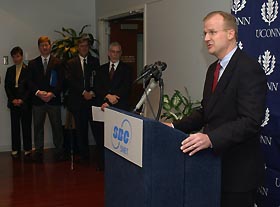|
This is an archived article.
For the latest news, go to the Advance
Homepage
For more archives, go to the Advance Archive/Search Page. |
||||
|
SBC SNET Establishes
Major Collection At Dodd Center By Art Sorrentino Connecticut telecommunications pioneer SBC SNET recently completed a significant donation of its early corporate archives to the Thomas J. Dodd Research Center. The announcement was made during a Jan. 28 ceremony at the Dodd Center, that coincided with the 125th anniversary of the company's founding.
SNET first entered into a partnership with the Dodd Center in 1998. Since that time, staff of the Dodd Center have been working to organize, preserve, and catalog the initial donations. "This is a wonderful addition to an extraordinary collection," said President Philip E. Austin during the ceremony. "We are proud and delighted to take this next step in a longstanding collaboration between the University and one of Connecticut's most vital corporations." The bulk of the SNET collection covers the period from the company's inception in 1878 to the breakup of the Bell System in 1983. Valued as a $3.8 million gift to Campaign UConn, it includes 50,000 photographs and 1.8 million individual documents. At 600 linear feet, the SNET archives make up the second largest private collection at the Dodd Center. SBC SNET, now a subsidiary of SBC Communications, traces its history back to the District Telephone Company of New Haven, which created the world's first commercial telephone exchange in 1878. A few weeks later, on Feb. 21, 1878, the company published the world's first phone directory, which consisted of 50 residential and business listings printed on a single sheet of paper. Following expansion into Hartford, Bridgeport, and Meriden, the District Telephone Company evolved into the Connecticut Telephone Company, and in 1882 became Southern New England Telephone (SNET). At its inception, SNET was operating 24 exchanges with more than 3,000 subscribers. Telephone service continued to grow at a rapid pace and by the end of its first 50 years the company had installed more than 300,000 telephones and exchanges statewide. "The University of Connecticut is the logical place for celebrating our 125th and housing our archives," said Bill Blase, president and CEO of SBC SNET. "Like UConn, we have a historical bonding with this state - in fact, our roots go back just three years earlier. Like UConn, we are upgrading our facilities so that the people of this state will be assured of having access to world-class education and telecommunications services. And, like UConn, our first and foremost allegiance is to Connecticut." President Austin noted that both SNET and its predecessor institutions and UConn and its predecessor institutions helped make Connecticut's evolution possible: "In the late 19th century, this was an agricultural state dotted with mill towns and small factory cities," he said. "We are now a state with an economy based heavily on knowledge, and specifically on information technology and communications. Both SNET and UConn have been critical to that transformation." The items in the collection include historical photographs of buildings, employees and equipment; town "telephone" histories; public relations and promotional materials; financial records, including early cash books beginning in 1880. Also annual reports; audiovisual materials; artifacts; and correspondence that includes notes from and about Mark Twain and his sometimes antagonistic experiences with the telephone. "The records of the Southern New England Telephone Company are a very important addition to the Dodd Center," said Thomas P. Wilsted, director of the Dodd Center. "The collection documents the history of one of the pioneer telecommunications companies in the United States and also provides information on local and regional activities, natural disasters, and the growth and change in local Connecticut communities. We are proud to house, preserve, and make available this important historical resource." The collection will be of value for a wide variety of research, he said, including:
With support from SBC SNET, the collection has been cataloged and oral histories have been created. A portion of the material is available on the Dodd Center website (http://www.lib.uconn.edu/DoddCenter), including the SNET-produced book titled, "The First Century of the Telephone in Connecticut." There are also two online exhibits and links to further resources on SBC SNET's website (www.sbc.com). "In the hands of the Dodd Center, a bunch of 'stuff' occupying 631 linear feet of shelf space was transformed into a unique collection of 1.8 million items - precious photos and materials that might otherwise have been lost or destroyed - all preserved with the dignity our history deserves," said Blase. "These are items of historic significance to our state, documenting disasters and tracing important historical events that have shaped our destiny." |


